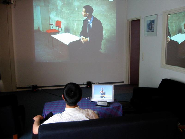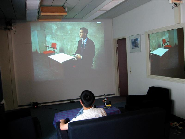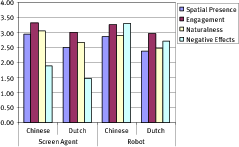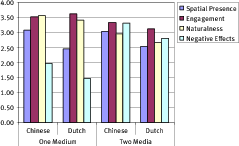Presence in a Distributed Media Environment
Den Dolech 2, 5600MB Eindhoven, The Netherlands
1 Introduction
Distribution is not a new idea for enhancing the entertainment experience. We have already been experiencing more realistic and more natural sounds from a multichannel surround sound system that distributes the sounds around us. The concept of ambient intelligence and pervasive computing enables more possibilities to distribute not only the audio, but also the content in other modalities into the end user’s environment. Interaction with these distributed contents may also change from pressing buttons on a remote control to other more direct and more tangible ways, such as directly touching the objects presented.
We may imagine that distribution would better utilize the physical environment with increased number and extent of sensory stimuli, embodiment would improve the liveness and the fidelity of a virtual character, and there would be better match between actions and reactions when interacting with such a embodied character, hence there should be more presence, a feeling of “being there” in the virtual world created by the media content [5, 3]. Another important factor influencing presence is the user characteristics [5, 3], one of which is the culture background. Some cultures are more long-term oriented and users from these cultures would be more tolerant to the distraction caused by distribution [7] and we expect they would feel more presence than users from short-term oriented cultures. Chinese and Dutch are good examples of these two cultures.
Based on the discussion, we define research questions as follows: What influence do the distribution of media and the embodiment of virtual characters have on the user’s presence experience? Would direct touching the presented content objects bring more presence than pressing buttons on remote controls? Would Chinese feel more presence than Dutch in interacting with distributed media?
2 Experiment
With the research questions in mind, we first made an interactive movie for the experiment. It was about a job interview in which the users had to make decisions for the applicant during two decision points, which resulted in four possible movie endings. Decisions could be made by interacting with either a remote control, a touch screen or a robot. The movie was designed to be neither too exciting nor too boring. The movie was played back using the software specially designed for distributed and interactive presentations [4, 2].
Then we conducted a 2 (Interaction) × 2 (Distribution) × 2 (Embodiment) × 2 (Nationality) mixed between/within experiment. Interaction and nationality were the between participant factors. Interaction had the conditions RemoteControl and DirectTouch, and nationality had the conditions Dutch and Chinese. Embodiment and distribution were within participant factors. Embodiment had the conditions ScreenAgent and Robot, and distribution had the conditions one and two media.
In OneMedium condition, both the touch screen and the robot were removed from the environment and the screen agent was present in the right bottom corner of the projected main screen, overlapping over the movie. The sizes of the screen agent and the robot were proportional to the distance from the user. In the Robot conditions, the touch screen was replaced with a Lego robot that had about the same height. In the ScreenAgent conditions, the touch screen displayed a full screen agent of the robot. The behavior of the screen based agent and the Lego robot were identical.
The experiment took place in a living room laboratory (see Fig. 1 ). The participants were seated on a coach in front of a couch table. The coach was 3.5m away from the 2.5m× 1.88m main screen, which was projected onto a wall in front. The 30cm× 23cm LCD touch screen was located 0.5m from the coach, standing on the table.
19 Chinese and 24 Dutch between the age of 16 and 48 (14 female, 29 male) participated in the experiment. The participants started with a training session, interacting with an unrelated interactive movie using a remote control. Then the real experiment started, which consisted of three movies and a questionnaire after each movie.
The questionnaire was based on the ITC-SOPI [6] and consisted of four components: 1) Spatial Presence, a feeling of being located in the virtual space; 2) Engagement, a sense of involvemen with narrative unfolding within virtual space; 3) Ecological validity, a sense of the naturalness of the mediated content; 4) Negative effects, a measure of the adverse effects of prolonged exposure to the immersive content.
3 Results
3.1 Embodiment, interaction and nationality effect
A 2 (embodiment) × 2 (interaction) × 2 (nationality) repeated measures ANOVA was conducted. Interaction had no significant influence on any of the measurements. Embodiment and Nationality both had significant influence on almost all measurements. Since the interaction had no influence on the measurements, the average of the screen and robot conditions was taken and summarized in Fig. 2(a) .
The measurements for Spatial Presence were significantly higher in the ScreenAgent condition than in the Robot condition. Negative Effects were significantly higher in the Robot condition than in the ScreenAgent condition. All measurements between the Dutch and the Chinese participants differed significantly, except for Engagement in the ScreenAgent condition, which just missed the significance level.
3.2 Distribution effect
To test for the effect of distribution, the average of the Robot and ScreenAgent conditions in the remote interaction conditions was taken. Fig. 2(b) shows the means in the nationality and distribution conditions. A 2 (distribution) × 2 (nationality) repeated measurements ANOVA was conducted. Both, Distribution and Nationality had a significant effect on the measurements.
It cannot be completely excluded that effect of the distribution is based on an order effect caused by the fact that we always presented the OneMedium condition first. However, since the order effect only appeared between the first and the second presentation, it appears to be insufficient to explain the phenomena completely. The distribution might have contributed to the difference seen in Fig. 2(b) .
4 Discussion and Conclusions
The different interaction methods (using a remote control or touching directly) had no influence on the measurements, but the influence of the culture background is clear on most of the measurements – Chinese participants perceived more presence than Dutch participants in all conditions as we expected. We can not reject the hypothesis that uses with a long-term oriented culture background, hence with more tolerance to distractions and frustrations, would perceive more presence in distributed environments.
The influence of Embodiment on all measurements does not conform to the expected results defined in the construct of presence. If the user experiences high presence then all measurements should be high, including Negative Effects. Furthermore, Spatial Presence should be positively correlated with Negative Effects. However, in our results Spatial Presence and Naturalness are higher in the ScreenAgent condition, while Negative Effects was higher in the Robot condition. Negative Effects appear to have been affected by something else than presence.
During the experiment, the robots motor emitted noise, which caused the participants to look at it. A moving physical object is potentially dangerous and hence attracts attention. The participants were frequently switching between looking at the movie and the robot and hence divide their attention. This switching made it hard for the users to stay focused and might cause the high negative experience. Eggen et al. [1] showed that a divided attention space reduced the users immersion.
Even with the methodological limitation of the distribution effect measurement we tend to believe that multiple media presentations decrease presence. We are currently planning an extension study to counterbalance the possible order effect, which will then provide a more exact answer.
References
1. B. Eggen, L. Feijs, M.d. Graaf, and P. Peters. Breaking the flow - intervention in computer game play through physical and on-screen interaction. In the ’Level Up’ Digital Games Research Conference, 2003.
2. L.M.G. Feijs and J. Hu. Component-wise mapping of media-needs to a distributed presentation environment. In The 28th Annual International Computer Software and Applications Conference (COMPSAC 2004), pages 250–257, 2004.
3. J. Freeman, J. Lessiter, and W. IJsselsteijn. An introduction to presence: A sense of being there in a mediated environment. The Psychologist, 14:190–194, 2001.
4. Jun Hu and Loe M. G. Feijs. An adaptive architecture for presenting interactive media onto distributed interfaces. In The 21st IASTED International Conference on Applied Informatics (AI 2003), pages 899–904, Innsbruck, Austria, 2003. ACTA Press.
5. W.A. IJsselsteijn, H.d. Ridder, J. Freeman, and S.E. Avons. Presence: concept, determinants, and measurement. Human Vision and Electronic Imaging V, 3959(1):520–529, 2000.
6. J. Lessiter, J. Freeman, E. Keogh, and J. Davidoff. A cross-media presence questionnaire: The itc sense of presence inventory. Presence: Teleoperators and Virtual Environments, 10(3):282–297, 2001.
7. A. Marcus and E.W. Gould. Crosscurrents: cultural dimensions and global web user-interface design. interactions, 7(4):32–46, 2000.




